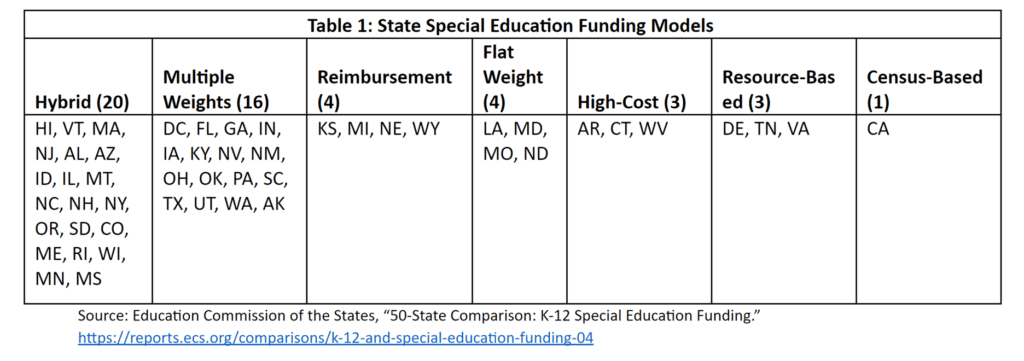K-12 students with disabilities require additional services and financial support to access equal educational opportunities. Generally, students are classified as special education (SPED) if they qualify for individualized education plans (IEPs) under the federal Individuals with Disabilities Education Act. Special education services pose a unique challenge in public K-12 education finance because special education students have a wide variety of needs that aren’t easily accommodated by state school finance formulas. This column provides background information on special education in the United States, surveys current state funding practices, and draws out some best practices for providing special education students equal education opportunities.
Background Facts on Special Education
The latest federal K-12 education data from the 2019-2020 school year indicates that 14.4 percent of public-school students receive SPED services. Over the last two decades, this population has grown from 13.1 percent of the public school population to 14.4 percent—or by about 840,000 students in absolute terms. The SPED population has also changed in the types of disabilities students are being diagnosed with. Education Week reports that between 2009-10 and 2019-20:
“The percent of students with disabilities who had a specific learning disability, like dyslexia, decreased from 37.5 percent to 33 percent in 2019-20. And the percent of students with disabilities with autism almost doubled, from 5.8 percent to 11 percent.”
Most SPED students in the United States have mild disabilities, often requiring only some additional support services. In fact, 64.8 percent of SPED students spend 80 percent or more of their school time in general education classrooms. But some disabilities require more resources to accommodate than others. Moreover, different students diagnosed with the same general disability (e.g. autism, deafness, blindness) can vary widely in the amount of time they spend outside of general classrooms.
These facts are important for policymakers to keep in mind when evaluating their current special education funding mechanisms.
Current State Special Education Funding Practices
There are six methods states currently use to support students with disabilities. Each state relies on either one or several of these methods to support its SPED students.
- Census-based funding. Some states assume each district has the same percentage of SPED students and therefore provides additional funding for each student (whether they have a disability or not) that is meant to be used for those students who do have a disability. This method is generally easy to administer. For example, each enrolled student in California public schools receives an extra $715 for special education whether they are SPED students or not.
- Flat weight for qualifying pupils. Under this model, states have a single weight multiplier that directs more K-12 formula dollars to qualifying SPED students only. States using a flat weight don’t distinguish between moderate or severe disabilities. Louisiana, for instance, applies a weight of 1.5 times their base per-pupil funding for any student with an IEP.
- Multiple weights. This method is very similar to the flat weighting method except for the fact that it does distinguish between SPED students with different levels of need. States using this method have different weights for SPED students that are based either on student disability diagnoses or the degree of additional services they require. As an example, Georgia categorizes SPED students in 5 different groups based on their disabilities with weights ranging from 1.4118 to 4.8710.
- High-cost services. This approach is generally designed for the minority of SPED students that require exceptionally greater resources to serve. While other methods such as a flat weight or Census-based funding can work well for most SPED students that spend much of their time in general classrooms and don’t require highly specialized services, high-cost funding is meant to the alleviate the financial burden in districts serving students that regularly require things like special transportation, occupational or language therapists, or certain health equipment. States using high-cost funding often reimburse districts for qualifying SPED expenditures either fully or in part. For instance, for SPED students in Arkansas who require more than $15,000 worth of services, the state fully reimburses them for any funds spent beyond $15,000 up to $65,000. Beyond $65,000, the state reimburses for 80% of the additional spending.
- Reimbursement. Rather than supporting SPED students by allocating additional revenues up front, some states simply reimburse school districts for their special education-related expenditures on the back end. Usually, states only reimburse some percentage of a district’s total SPED expenditures. For example, Michigan reimburses school districts for 28.6138% of their approved SPED education costs and 70.4165% of their approved SPED transportation costs.
- Resource-based. This SPED funding method is most prevalent in states that already have a resource-based school funding system. That is, they already have a funding system that appropriates staff and services to school districts based on assumptions of what typical students need and standardized staffing ratios. States with a resource-based funding system, therefore, also fund SPED students in this way by allocating additional staff and services to qualifying students based on assumptions about what those students need. Tennessee, for example, allocates specific amounts of teachers, supervisors, assistants, and other services and personnel based on standardized staffing ratios. These ratios vary based on the severity of a student’s disability.
Table 1 summarizes which states use these methods.

Note from Table 1 that many states use a hybrid approach—blending more than one of the six SPED funding approaches outlined earlier in this column. The 20 states using a hybrid approach often combine one method that best serves the bulk of SPED students with mild disabilities with another method targeted for students with severe disabilities. For instance, a number of states in the northeast (Massachusetts, New Hampshire, New York, New Jersey) use a combination of census-based funding and high-cost services funding.
Best Practices for States Considering Reform
There is no one right way to fund special education because each student and school district is unique. However, several principles can be a useful guide for lawmakers looking to improve how they fund special education students.
- Distinguish between mild and severe disabilities. While a flat weight or a census-based approach can work well for many students with mild disabilities and is easy to administer, states that rely solely on these methods run the risk of saddling districts that serve high-cost students with a severe financial burden. For small school districts, serving even one or two students with a severe disability can have significant implications for their budgets. States need to have differentiated funding to support SPED students with comprehensive additional needs.
- Don’t fund students based on specific disability diagnoses. Some states that use multiple weights for SPED categorize students based on their disability category (e.g. autism, hearing impairment, emotional disturbance, etc.). But as was covered early in this column, students in the same disability category can demand different magnitudes of additional services. Policymakers, therefore, should determine resources based on the additional services required by a student’s IEP.
- Ensure districts have good financial incentives. State education funding policies should incentivize good practices in the provision of special education services at the district level. Policymakers need to regularly evaluate their funding weights to ensure they don’t lead to the overidentification or underidentification of special education students. Also, SPED funding policies should be sensitive to resource scarcity. As a cautionary example, until 2018-2019 Wyoming fully reimbursed school districts for their special education costs—a policy that had caused steady increases in the state’s SPED spending that had to be capped due to the excessive costs. Additionally, states should avoid incentivizing districts to place SPED students in more restrictive environments. Texas, for example, directs greater resources to students who are largely separated from their non-SPED peers. Some practitioners in the state argue this practice creates a perverse incentive for school districts to keep SPED students out of general classrooms because it leads to greater funding.
- Facilitate and allow for innovation. Balancing adequate services with cost-effectiveness is the perennial challenge of special education funding. Therefore, funding models that discourage districts from using different service models to fit local needs—such as resource-based funding or flat reimbursements for SPED expenditures—aren’t favorable. Instead, states should give districts flexibility in how they manage SPED services while also ensuring resources are roughly commensurate with additional student needs.
Some states have positive features in their SPED funding formulas that other states could learn from. For example, Florida divides SPED students into five levels that vary based on the degree of additional needs students require beyond general classrooms. Students in the lower-need groups (Levels 1-3) are funded by a block grant that doesn’t vary based on the specific number of students a district has in those mild need categories. However, students in Levels 4 and 5 are individually counted and supported with additional weights of 2.648 and 4.34, respectively. Florida’s system avoids some of the pitfalls that other states fall into—it distinguishes between mild and severe disabilities and it weights based on the intensity of need rather than specific disability diagnoses.
No state funding system for special education is perfect. But the principles highlighted in this column and the example provided by a state like Florida provides policymakers with a good starting point when considering reforms.

